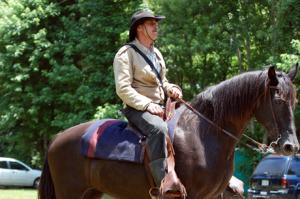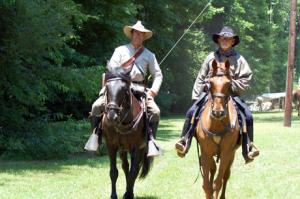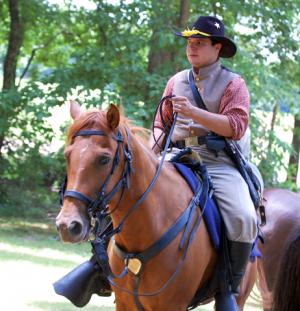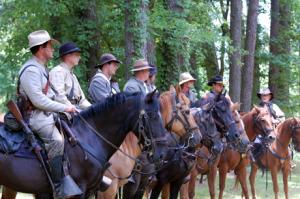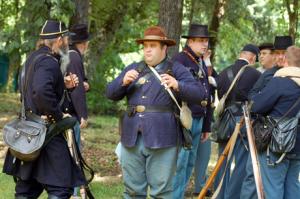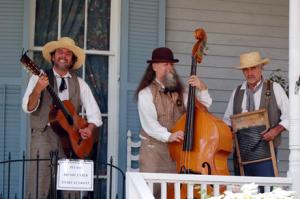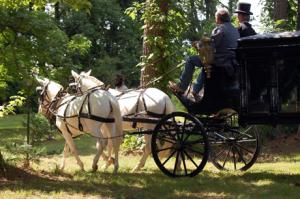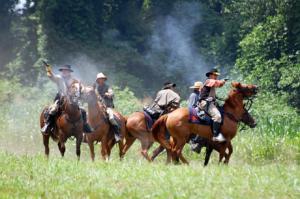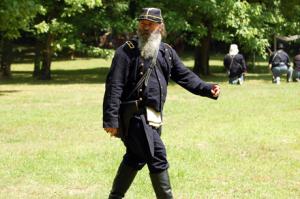By Tommy Brannon
The Confederate Cavalry was well represented at a reenactment of Hernando, MS June 15 -16 at Mussacuna Plantation south of Hernando, just a few miles from where the actual battle took place 150 years ago. Masscuna, circa 1849, is the home of Eddie Burks, a member of the 17th Mississippi Re-enactors Infantry and the owner of the restored antebellum Robertson-Yates house, around which battle's re-enactment took place. The weather was sunny and warm, a little hot for the re-enactors dressed in wool uniforms and the southern bells in their hoop skirts, but perfect for the spectators sitting in the shade.
The actual battle, which took place on June 19, 1863, was primarily a cavalry engagement between the federal detachments of 1st Missouri, 2nd Illinois and 5th Ohio Cavalry commanded by Maj. John Henry, portrayed by Larry McCluney of Greenwood, MS and the Confederate 7th Tennessee Cavalry who were under the field command of Col. William C. Falkner, portrayed by Paul Alford of Horn Lake, MS. Col. Falkner was the grandfather of Mississippi author William Faulkner who later added a “u” to the family surname. Major Henry and 87 federal troops were captured in the battle and transported to Libby Prison in Richmond, VA where he later led an escape with 107 other prisoners.
In addition to the depiction of the battle (one on Saturday and one on Sunday) there was entertainment by a musical group named Lost Cause playing authentic civil war songs, a Confederate Ball on Saturday night, and a re-internment of the remains of 3 members of the Robertson family. The Robertson’s were the original settlers in the area and built the Robertson-Yates plantation house. Anna Alisa Robertson, Susan Ragan Robertson and Martha Robertson Douglass all died in the 1840’s and had been previously buried in a family cemetery nearby. The cemetery had been forgotten and vandalized so Eddie Burks received permission to relocate the graves and markers on the grounds of Massacuna. With the help of Hernando Funeral Home, a glass mule-drawn hearse, courtesy of Meredith-Nowell Funeral Home in Clarksdale, MS and a horse drawn funeral caisson from Memphis Carriages, the remains were buried in a reverent, very moving, period ceremony.
Fourteen riders of the 7th Tennessee Cavalry bivouacked on the grounds depicting how the civil war cavalry lived and fought. Father and daughter Jimmy and Kayla Eick make re-enacting a family event. Kayla dresses as a man and rides her Arabian mare Sadori, which is also her foxhunting horse. She surprised the crowd by jumping a fence during a charge. Chuck Brown of Atoka, TN rode his 15-year-old crossbred gelding, Taz. Sam Eyna from Pea ridge, AR rode his 16-year-old Missouri Fox Trotter, Sonny. Sam said that he also rides Sonny in Cowboy mounted shooting. He likes to start colts and gets them used to a lot of noise by rattling chains and cans of rocks. He said he participates in about eight to ten such history events per year. He was brandishing a large, heavy .45cal long colt pistol in the battle. Larry Dixon from Olive Branch, MS was mounted on his 8-year-old Quarter horse, Jack. Larry said Jack has a good temperament and took to all of the noise of battle well. He will at times fire a sawed off shotgun when mounted on Jack. Latham Brister of Houston, MS rode Yatzee, a 6-year-old Quarter horse who is usually used in roping competition. This was the first time Yatzee had experienced gunfire or seen battle. He had not even been exposed to it in practice, but behaved like a veteran war horse working in the formations. David Wilson was riding his 15-year-old saddle bred, Bubba, who is a reenactment veteran of 6 or 7 years. David said that he has tried horses that did not work well for reenacting at all. He mentioned a particular thoroughbred that would fight him more than the Yankees, not being fun for him or the horse. He commented that one of the differences between cavalry and infantry is that with cavalry there are two brains to worry about in the battle. Chuck Tarwater from Millington, TN has been reenacting for more than 20 years. Chuck has 4 horses- 2 quarter horses, an appaloosa and that day’s mount, and a Tennessee Walking horse named Jack. Jack started out as a field trial horse and is a very smooth ride. Chuck said that he works a horse in the round pin and introduces him to gunfire by shooting from the other side of the pen but there is no way to acclimate a horse to cannon fire except at the battle. He has had Jack for three years.
The spectators were able to watch all of the action as the battle progressed around the house observing the loud booming of cannon, good horsemanship, with cavalry maneuvering in tight formation, and an infantry charge complete with a Rebel yell. When the action had ended both sides lined up in formation and honored the solders that fought and died in the Civil War from both sides.
Photo cutlines:
DSC_0001 Jimmy Eick
DSC_0005 Chuck Brown and Sam Eyna
DSC_0007: cavalry lining up for formation
DSC_0022: southern bells at the civil war reenactment in Hernando ( left to right) Shelly Autry of Collierville, TN; Robyn Capps of Aberdeen, MS; Faye Sartor of Collierville, TN; Paula Lincoln of Eads, TN; Dare Dorris of Southhaven, MS
DSC_0090: a glass mule-drawn hearse, courtesy of Meredith-Nowell Funeral Home in Clarksdale MS
DSC_0042: cavalry in action
The Confederate Cavalry was well represented at a reenactment of Hernando, MS June 15 -16 at Mussacuna Plantation south of Hernando, just a few miles from where the actual battle took place 150 years ago. Masscuna, circa 1849, is the home of Eddie Burks, a member of the 17th Mississippi Re-enactors Infantry and the owner of the restored antebellum Robertson-Yates house, around which battle's re-enactment took place. The weather was sunny and warm, a little hot for the re-enactors dressed in wool uniforms and the southern bells in their hoop skirts, but perfect for the spectators sitting in the shade.
The actual battle, which took place on June 19, 1863, was primarily a cavalry engagement between the federal detachments of 1st Missouri, 2nd Illinois and 5th Ohio Cavalry commanded by Maj. John Henry, portrayed by Larry McCluney of Greenwood, MS and the Confederate 7th Tennessee Cavalry who were under the field command of Col. William C. Falkner, portrayed by Paul Alford of Horn Lake, MS. Col. Falkner was the grandfather of Mississippi author William Faulkner who later added a “u” to the family surname. Major Henry and 87 federal troops were captured in the battle and transported to Libby Prison in Richmond, VA where he later led an escape with 107 other prisoners.
In addition to the depiction of the battle (one on Saturday and one on Sunday) there was entertainment by a musical group named Lost Cause playing authentic civil war songs, a Confederate Ball on Saturday night, and a re-internment of the remains of 3 members of the Robertson family. The Robertson’s were the original settlers in the area and built the Robertson-Yates plantation house. Anna Alisa Robertson, Susan Ragan Robertson and Martha Robertson Douglass all died in the 1840’s and had been previously buried in a family cemetery nearby. The cemetery had been forgotten and vandalized so Eddie Burks received permission to relocate the graves and markers on the grounds of Massacuna. With the help of Hernando Funeral Home, a glass mule-drawn hearse, courtesy of Meredith-Nowell Funeral Home in Clarksdale, MS and a horse drawn funeral caisson from Memphis Carriages, the remains were buried in a reverent, very moving, period ceremony.
Fourteen riders of the 7th Tennessee Cavalry bivouacked on the grounds depicting how the civil war cavalry lived and fought. Father and daughter Jimmy and Kayla Eick make re-enacting a family event. Kayla dresses as a man and rides her Arabian mare Sadori, which is also her foxhunting horse. She surprised the crowd by jumping a fence during a charge. Chuck Brown of Atoka, TN rode his 15-year-old crossbred gelding, Taz. Sam Eyna from Pea ridge, AR rode his 16-year-old Missouri Fox Trotter, Sonny. Sam said that he also rides Sonny in Cowboy mounted shooting. He likes to start colts and gets them used to a lot of noise by rattling chains and cans of rocks. He said he participates in about eight to ten such history events per year. He was brandishing a large, heavy .45cal long colt pistol in the battle. Larry Dixon from Olive Branch, MS was mounted on his 8-year-old Quarter horse, Jack. Larry said Jack has a good temperament and took to all of the noise of battle well. He will at times fire a sawed off shotgun when mounted on Jack. Latham Brister of Houston, MS rode Yatzee, a 6-year-old Quarter horse who is usually used in roping competition. This was the first time Yatzee had experienced gunfire or seen battle. He had not even been exposed to it in practice, but behaved like a veteran war horse working in the formations. David Wilson was riding his 15-year-old saddle bred, Bubba, who is a reenactment veteran of 6 or 7 years. David said that he has tried horses that did not work well for reenacting at all. He mentioned a particular thoroughbred that would fight him more than the Yankees, not being fun for him or the horse. He commented that one of the differences between cavalry and infantry is that with cavalry there are two brains to worry about in the battle. Chuck Tarwater from Millington, TN has been reenacting for more than 20 years. Chuck has 4 horses- 2 quarter horses, an appaloosa and that day’s mount, and a Tennessee Walking horse named Jack. Jack started out as a field trial horse and is a very smooth ride. Chuck said that he works a horse in the round pin and introduces him to gunfire by shooting from the other side of the pen but there is no way to acclimate a horse to cannon fire except at the battle. He has had Jack for three years.
The spectators were able to watch all of the action as the battle progressed around the house observing the loud booming of cannon, good horsemanship, with cavalry maneuvering in tight formation, and an infantry charge complete with a Rebel yell. When the action had ended both sides lined up in formation and honored the solders that fought and died in the Civil War from both sides.
Photo cutlines:
DSC_0001 Jimmy Eick
DSC_0005 Chuck Brown and Sam Eyna
DSC_0007: cavalry lining up for formation
DSC_0022: southern bells at the civil war reenactment in Hernando ( left to right) Shelly Autry of Collierville, TN; Robyn Capps of Aberdeen, MS; Faye Sartor of Collierville, TN; Paula Lincoln of Eads, TN; Dare Dorris of Southhaven, MS
DSC_0090: a glass mule-drawn hearse, courtesy of Meredith-Nowell Funeral Home in Clarksdale MS
DSC_0042: cavalry in action
